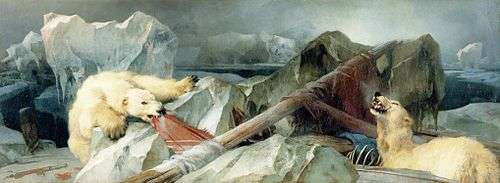Man Proposes, God Disposes
Man Proposes, God Disposes is an 1864 oil-on-canvas painting by Edwin Landseer. The work was inspired by the search for Franklin's lost expedition which disappeared in the Arctic after 1845. The painting is in the collection of Royal Holloway, University of London, and is the subject of superstitious urban myth that the painting is haunted.
| Man Proposes, God Disposes | |
|---|---|
 | |
| Artist | Edwin Henry Landseer |
| Year | 1864 |
| Dimensions | 91.4 cm × 243.7 cm (36.0 in × 95.9 in) |
| Location | Royal Holloway, University of London |
Description
The painting adopts the dark tones of Landseer's later works. The scene shows two polar bears among the scattered wreckage of the expedition – a telescope, the tattered remains of a red ensign, a sail, and human bones, which William Michael Rossetti called "the saddest of membra disjecta". The image shows humanity and civilization defeated by "nature, red in tooth and claw", and can be seen as a commentary on the crisis of British triumphalism and imperialism in the middle of the 19th century.
Background
The painting depicts an imagined Arctic scene in the aftermath of Sir John Franklin's expedition in 1845 to explore the Northwest Passage.
The 134 men of Franklin's exhibition left Greenhithe in May 1845 on two steam-powered ironclad icebreakers, HMS Erebus and HMS Terror. After five left the ship, the remaining 129 men were last seen by a whaling vessel in Lancaster Sound in July 1845, but then disappeared without trace into the ice. The expedition was well-provisioned for a voyage of several years, but eventually, search parties were sent out as time passed and no further sightings were made. In 1854, Inuit recounted tales of sightings in 1850 to Captain John Rae of the Hudson's Bay Company, and he found some dead bodies on King William Island. Rae also reported suspicions of cannibalism among the last survivors.
In 1859, Francis Leopold McClintock published The Voyage of the Fox in the Arctic Seas, an account of his voyage on the Fox in search of Franklin from 1857 to 1859, and his discovery of the remains of two crew from Erebus on King William Island earlier in 1859, together with the ship's boat and other detritus.
The painting may also have been inspired by Caspar David Friedrich's 1824 painting The Sea of Ice, and Frederic Edwin Church's The Icebergs, which was first exhibited in New York in 1861 and shown in London in 1863.
Origin of the title

The phrase "Man proposes, but God disposes" is a translation of the Latin phrase "Homo proponit, sed Deus disponit" from Book I, chapter 19, of The Imitation of Christ, a 15th-century book by the German cleric Thomas à Kempis. A few modernized and paraphrased Bible translations use it as a translation of Proverbs 19:21, but the original of that verse is longer and more elaborate.
The phrase was also put on a Dutch commemorative medal celebrating the Elizabethan England Protestant victory in 1588 over the Catholic Spanish Armada.
A similar but much earlier usage appears in the concluding lines of Lucian's "Symposium" (circa 150 AD), quoting from the concluding lines of Euripides's Alcestis, Andromache, Helen, and Bacchae (5th century BC): "πολλὰ δ᾽ ἀέλπτως κραίνουσι θεοί" (loosely translated, "the gods bring many matters to surprising ends").
Reception
The painting was exhibited at the 1864 Royal Academy summer exhibition. Lady Franklin was invited to the exhibition, but avoided the "offensive" painting.
The Art Journal described its "poetry, pathos, and terror" and "tragic grandeur", the Athenaeum noted an "epic" quality, and the Saturday Review praised its "sublimity of sentiment". The painting was sold at auction to Thomas Holloway in 1881. It currently hangs in the picture gallery of Royal Holloway, University of London.
Urban myth
It is well-documented that students at Royal Holloway believe the painting is haunted.[1][2][3] It comes from the urban myth that a student sitting their exams in the 1920-30s stabbed a pencil into their eye, writing "The polar bears made me do it" on to their exam paper, in reference to the painting, and committing suicide.[4] There is, however, no university record of death in the picture gallery.[3] The college's curator, Dr. Laura MacCulloch, explained about the myth, saying that "if you sit directly in front of it in an exam, you will fail - unless it's covered up".
Due to the perception that the painting is a bad omen, there is a college tradition that requires temporarily covering the painting with a Union Jack when student examinations are ongoing.[3] This is due to an incident during the 1970s where an exam invigilator hurriedly covered the painting with the first thing they could find that would be large enough, as a student refused to sit their exam by the uncovered painting.[4][2]
References
- https://www.youtube.com/watch?v=3coSAkzrn28
- MacCulloch, Laura. "The haunted painting of fabled Franklin ship discovered in the Canadian Arctic". The Conversation.
- https://www.huffingtonpost.co.uk/2014/09/15/students-at-royal-holloway-fear-this-eerie-painting_n_5821174.html
- "The polar bears made me do it". September 13, 2014 – via www.bbc.co.uk.
- The Arctic Fantasies of Edwin Landseer and Briton Riviere: Polar Bears, Wilderness and Notions of the Sublime, Diana Donald. Tate Papers Issue 13, 1 April 2010.
- "The cravings of nature": Landseer’s Man Proposes, God Disposes and the Franklin Expedition, Sophie Gilmartin, Royal Holloway, 2008 (‘The cravings of nature’: Landseer’s Man Proposes, God Disposes and the Franklin Expedition - Research - Royal Holloway, University of London)
- Edwin Landseer, Man Proposes, God Disposes, 1864, Laura MacCulloch, Royal Holloway, May 2013.
- Sir Edwin Landseer's Man Proposes, God Disposes: And the fate of Franklin, Andrew Moore, The British Art Journal, Vol. 9, No. 3 (Spring 2009), pp. 32–37.
- The painting reputed to make students fail exams, BBC News magazine, 13 September 2014.